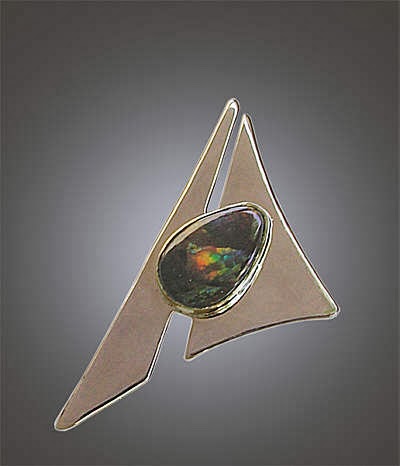The most
valuable color of Sapphire is a cornflower blue color, known as Kashmir.
Sapphire or Cornflower blue
Sapphire. Another extremely valuable Sapphire form is the very rare,
orange-pink Padparadcchah. An exotic type of sapphire, known as Color Changing Sapphire, displays a
different color depending on its lighting. In natural light, Color Changing
Sapphire is blue, but in artificial light, it is violet. (This effect is the
same phenomenon well-known in the gemstone Alexandrite). Yellow and pink Sapphire have recently become very
popular, and are now often seen in jewelry.


Sapphire often contains minor inclusions
of tiny slender Rutile needles.
When present, these inclusions decrease the transparency of
a stone and are known as silk.
When in dense, parallel groupings, these inclusions can actually enhance by
allowing polished Sapphires to exhibit asterism. Sapphire gems displaying
asterism are known as "Star Sapphire", and these can be highly
prized. Star Sapphire exists in six ray stars, though twelve ray stars are
also known.
Sapphire is pleochroic ,
displaying a lighter and more intense color when viewed at different angles.
Some pleochroic Sapphire is blue when viewed at one angle, and purple at a
different angle. Color zoning, which forms from growth layers that build up
during the formation of the stone, may also be present in certain Sapphires.
Color zoning is responsible for certain Sapphires having lighter and darker
colors in different parts of a crystal. Some Sapphire gemstones may even be
multicolored such as purple and blue.
Sapphire is a tough and durable gem and the only natural gemstone harder than
Sapphire is Diamond. Despite this,
Sapphire is still subject to chipping and fracture if handled roughly, and
care should be taken to ensure it is properly handled. Sapphire was first
synthesized in 1902. The process of creating synthetic Sapphire is known as
the Verneuil process Only
experts can distinguish between natural and synthetic Sapphire.

Source of color
Rubies are corundum which
contains chromium impurities that absorb yellow-green light and
result in deeper ruby red color with increasing content. Purple
sapphires contain trace amounts of vanadium and come in a variety of
shades. Corundum that contains ~0.01% of titanium is colorless.
If trace amounts of iron i are present, a very pale yellow
to green color may be seen. If both titanium and iron impurities are present
together, however, the result is a magnificent deep-blue color.
Unlike localized ("intra-atomic")
absorption of light which causes color for chromium and vanadium impurities,
blue color in sapphires comes from intervalence charge transfer, which is the
transfer of an electron from one transition-metal ion to another via the
conduction or valence band. The iron can take the form Fe2+ or
Fe3+, while titanium generally takes the form Ti4+. If
Fe2+ and Ti4+ions are substituted for Al3+,
localized areas of charge imbalance are created. An electron transfer from Fe2+ and
Ti4+ can cause a change in the valence state of
both. Because of the valence change there is a specific change in energy for
the electron, and electromanetic energy is absorbed. The wavelength of
the energy absorbed corresponds to yellow light. When this light is
subtracted from incident white light, the complementary color blue results.
Sometimes when atomic spacing is different in different directions there is
resulting blue-green dichroism.
Intervalence
charge transfer is a process that produces a strong colored appearance at a
low percentage of impurity. While at least 1% chromium must be present in
corundum before the deep red ruby color is seen, sapphire blue is apparent
with the presence of only 0.01% of titanium and iron.
Treatments
Sapphires may be
treated by several methods to enhance and improve their clarity and color; It
is normally done by heat treatment. Heating the sapphires in furnaces to
temperatures between 500 and 1800 °C for several hours or by heating in a
nitrogen-deficient atmosphere oven for seven days or more is the common process.
Upon heating, the stone becomes bluer in color, but loses some of the rutile
inclusions (silk). Un-heated natural stones are somewhat rare and
will often be sold accompanied by a certificate from an independent
gemological laboratory attesting to "no evidence of heat treatment.
"Yogo sapphire
sometimes do not need heat treating because their cornflower blue coloring is
uniform and deep, they are generally free of the characteristic inclusions,
and they have high uniform clarity. At that time, 95% of all the
world's sapphires were being heated to enhance their natural color.
Diffusion treatments are used to add
impurities to the sapphire to enhance color. Typically beryllium is
diffused into a sapphire under very high heat, just below the melting point
of the sapphire. Initially (c. 2000) orange sapphires were
created, although now the process has been advanced and many colors of
sapphire are often treated with beryllium. The colored layer can be removed
when stones chip or are repolished or refaceted, depending on the depth of the
impurity layer. Treated padparadschas may be very difficult to detect, and
many stones are certified by gemological labs.
Transparency and hardness
One application
of synthetic sapphire is sapphire glass. Here glass is
a layman term which refers not to the amorphous state, but to the
transparency. Sapphire is not only highly transparent to wavelengths of light
between 150 nm (UV) and 5500 nm (IR) (the human eye can discern
wavelengths from about 380 nm to 750 nm), but is also
extraordinarily scratch-resistant. Sapphire has a value of 9 on the Mohs
scale of mineral hardness.
Sapphire Comes From:-
Important Sapphire
sources include Sri Lanka, Burma (Myanmar), Thailand, Cambodia, Madagascar,
Tanzania, Australia, and the U.S. (Montana). The Kashmir region of
India/Pakistan was famous for its Kashmir-blue Sapphire, but little material
comes from there today.
|




























